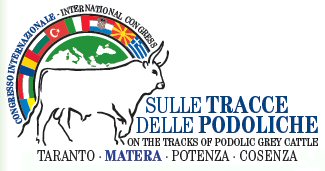
 |
July 9th-12th, 2009 |
The Podolica strain comprises an ancient group of cattle breeds, considered the most direct descendants of the European wild bull (Bos primigenius), which probably became extinct in the 17th century.
Of this group, the most representative, in terms of numbers, are the Podolica, Maremmana, Romagnola, and Marchigiana, all bred in Italy, and the Hungarian Grey, while the other European Podolica breeds (Boz Irsk, Istrian Cattle, etc.) have populations of limited numbers, risk extinction, or are even totally extinct.
At the present time, in consideration of the growing attention paid to biodiversity and the safeguard of local genotypes, various countries are implementing plans for the recovery of these autochthonous cattle breeds.
In particular, in recent years Hungary has built up the population of the Hungarian Grey breed, going from a few hundred animals to around 4,000 today.
A similar route has been embarked upon by Croatia for the Istrian Ox, of which there are only 400 today, but for which a project for its safeguard has been launched in collaboration with Italian partners, including the ANABIC and the University of Padua.
In 2006 Slovenia, which has almost totally lost the Slavonic Podolica strain and is interested in rebuilding a group of Podolica strain cattle, imported Italian Podolica embryos, Italy’s first case of germoplasm export abroad for this breed.
In Italy itself, regions which in the past had a high number of these animals, such as Friuli Venezia Giulia, have expressed their interest in re-introducing the Podolica cattle, and visited breeding farms in Basilicata and Calabria for this purpose.
Themes and Objectives of the Conference
On the basis of the considerations expressed above, the idea of an international conference devoted to the following themes and with the following aims was hatched:
Why in Basilicata
With around 25,000 animals bred, the Podolica, reared in Basilicata, Calabria, Campania, and Apulia, is the most important Italian breed, number-wise, of direct Podolica descent, and therefore also the most representative in Europe (the Marchigiana, which has a larger population, has however a less direct descent, since it is the product of a cross between a breed of the Podolica strain, the Romagnola, and one of a different origin, the Chianina).
In particular, Basilicata, with over 13,000 animals bred, is the top Italian breeding region. The local breeders’ associations follow over 300 farms and have gained a deep and precise expertise in the sector, enriched by the recent experience of “Orizzonti Lucani”, the regional mark aimed at enhancing livestock productions deriving from Podolica cattle.
Moreover, since 1996, the Podolica Bull Calf Selection Centre, run by the ANABIC in collaboration with the local Provincial Breeders’ Associations, has been in operation in the town of Laurenzana (Potenza). A national level structure which also receives bull calves from the other breeding regions, it is by now a fundamental point of reference for breeders who wish to purchase sires that are certified from the health, genealogical, morphological, and productive standpoints.
Also, last May, the ANABIC, the Provincial Breeders’ Associations, and the Agriculture Department of the Region of Basilicata signed a memorandum of understanding that envisages, among the contemplated actions, the holding of international congresses, conferences, and events. Precisely for the purpose of the organization of the International Congress on Podolica Cattle Breeds, a delegation made up of representatives of the ANABIC, Provincial Breeders’ Associations, and Agriculture Department of the Region of Basilicata, at the invitation of the Rural Development Agency of the Region of Istria, visited Croatia in late October 2008 to present the initiative, to which Croatia has already ensured its participation.
The ancient and atmospheric town of Matera have been chosen as the ideal venue for the holding of the event.